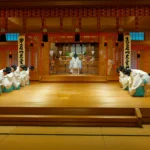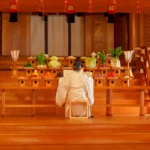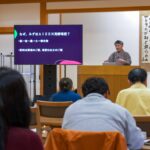Oomoto participates in the first Sant’ Egidio interfaith prayer service held in the United States
By Bill Roberts
Washington, D.C. – In a show of solidarity for the power of interfaith dialogue, more than one hundred religious leaders from around the world – including Christians, Muslims, Jews, Hindus, Buddhists and Shintoists — paraded arm-in-arm through the streets of the Georgetown district of the American capital and onto the Georgetown University campus for the closing ceremony of the International Prayer for Peace.
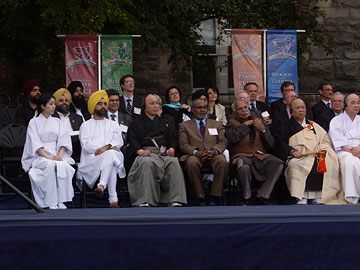
at the closing ceremony.
The closing capped a day of interfaith dialogue on various topics related to the conference theme of “Religion and Cultures: The Courage of Dialogue,” and a one-hour prayer for peace by each religious leader attending the conference, including the Reverend Tokio Kanakogi of Oomoto.
The closing was held April 27, 2006, on a balmy mid-spring evening, on the campus mall in front of an outdoor audience estimated by university officials at 2,000 and including members of various religious organizations, university students, civic and government leaders, and members of the Washington diplomatic corps.
In a proclamation for peace, signed by each religious leader during the closing ceremony, and read to the audience, the leaders declared:“Humanity is not made better by violence and terror, but by faith and love. Fundamentalism is the childhood disease of all religions and cultures, for it imprisons people in a culture of enmity. … Dialogue is an art. It is not the choice of the fearful, of those who give way to evil without fighting. Dialogue challenges all men and women to see the best in others and to be rooted in the best of themselves. Dialogue is a medicine that heals wounds and helps make this world more livable for present and future generations. Once again, today, we solemnly ask ourselves and all men and women, believers and people of good will, to have the courage to live the art of dialogue. We ask this for ourselves and for the generations to come, that the world may open to the hope of a new era of peace and justice.”
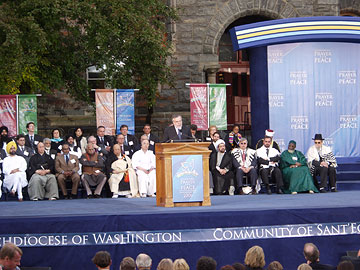
addresses the closing ceremony.
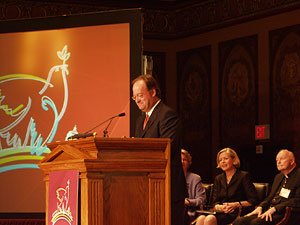
addresses the opening ceremony
The proclamation continued:
“Men and women of different religions, from the different continents of this world, we have gathered in America for the first time, guided by the spiritual energy of the ‘spirit of Assisi.’ Here in Washington, D.C., we have prayed, we have dialogued, and we have invoked God for the great gift of peace.”
The proclamation was read by the Reverend Constance Wheeler of the A.M.E. Church, a Protestant sect. She is the spiritual advisor for Georgetown University’s Protestant students and for the Georgetown University Gospel Choir, which performed for the crowd after the closing. Georgetown University, founded by the Jesuits, is the oldest Catholic university in America. It has a long tradition of fostering interfaith programs on campus and has active student groups across the religious spectrum, especially Catholics, Protestants, Jews, and Muslims.
After the proclamation was read and signed, children from the Holy Trinity Catholic School in Georgetown marched onto the stage and received copies of the declaration from the religious leaders. They then presented the copies to the members of the diplomatic corps and civic and government leaders.
The International Prayer for Peace was sponsored by the Community of Sant’Egidio, the Catholic Archdiocese of Washington, D.C., Georgetown University and the Catholic University of America, also located in Washington. It marked the 20th anniversary of Pope John Paul II’s historic interfaith gathering for peace in Assisi, Italy.
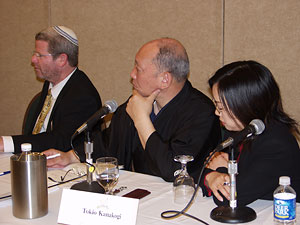
discussion on genocide.
It was the first time this annual event has been held in the United States.
“Welcome to Washington, welcome to this great city,” Cardinal Theodore McCarrick, the Catholic Archbishop of Washington, said in greeting the participants at the opening event on the night of April 26. “It is a city where we know something about peace and we know something about the absence of peace. It is so important that we come together to pray for peace at this time.”
Previous prayer conferences were held in Lyons, Milan, Rome, Bucharest, Warsaw and elsewhere in Europe. Oomoto priests have attended many of these prayer meetings. Oomoto’s participation in these and other interreligious activities is based on its doctrine of “Bankyo Dokon,” expressed by Co-Founder Onisaburo Deguchi. It loosely translates as “all religions spring from the same source.” Oomoto means “the great source,” or “the great origin.”
At the opening ceremony, John J. DeGioia, the president of Georgetown University said:
“This conference provides a perfect nexus for us to bring together the strengths and resources of the Academy with those of the religious, the political, and the instruments of civil society in ways in which together we can contribute to respond to the significant challenges that we face in our world today. I’m immensely honored by Georgetown’s role in this conference. And it is an honor and a privilege to be a part of bringing the Community of Sant’Egidio across the Atlantic Ocean to share with all of us the witness and testimony of this extraordinary organization.”
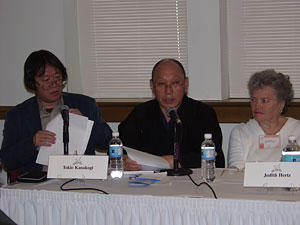
on religion in the globalized world.
DeGioia read a letter from President George W. Bush, which said in part:
“The International Prayer for Peace Conference provides a forum for participants to discuss international cooperation and share ideas for reaching out to our brothers and sisters in need. This year’s theme, “Religions and Cultures, the Courage of Dialogue,” reminds us of the importance of advancing mutual understanding and respect to achieve peace. A tolerant and inclusive society must respect the right to worship freely, and my administration remains committed to promoting religious freedom and human dignity. Religious bigotry must be rejected in every form, so that all people may live in accordance with their own beliefs and faith.”
To set the stage for the following day’s panels, the opening session ended with a panel discussion on “People of Faith and the Courage of Dialogue.” One of the panelists was Chief Rabbi Shean-Yashuv Cohen, the chief rabbi of Haifa, Israel. A friend of Oomoto, Rabbi Cohen visited Oomoto about 15 years ago for a World Federation meeting. Other members of the opening panel in Georgetown were the Most Reverend Diarmuid Martin, Archbishop of Dublin, Ireland, and Imam Warith D. Mohammed, a leading Islamic leader in the U.S.

Georgetown in Washington, D.C.
The next day, April 27, about a dozen panel discussions were held. Religious leaders, scholars and others exchanged ideas on a host of topics including the role of religion in democracy, the role of religion in solving poverty, religious freedom, religion and culture, religion and terrorism, religion’s role in stopping genocide, and the role of religion in the globalized world.
Participating in the panel on the role of religion in the globalized world, the Reverend Kanakogi talked about the importance of nature to Oomoto specifically and to Shinto and Japanese culture in general. He urged respect for nature and the environment.

“We must live in harmony with nature,” he said. “Believers in Shinto find divinity in nature and if we live in harmony with nature then we are living in harmony with the divinity.”
The main sponsor of the event, the Community of Sant’Egidio, based in Rome, was founded in 1968 and today is a worldwide movement of more than 50,000 Catholic lay people, dedicated to living according to the teachings of Jesus, interreligious dialogue, peace, justice and service.
The community gained worldwide acclaim for helping to negotiate an end to the long-running civil war in Mozambique, and has been nominated in the past for the Nobel Peace Prize. In 1999, the community was awarded the prestigious Niwano Peace Prize by the Niwano Peace Foundation of Japan.
— end–
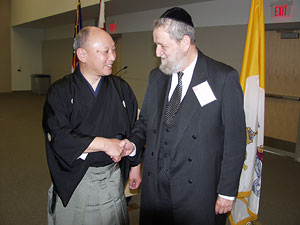
Shean-Yashuv Cohen, the chief rabbi of Haifa, Israel.

